lawmen
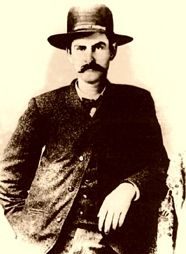 He came from a family of seafaring lawmen in Massachusetts, and a long line of English sailors of the Seven Seas. Nevertheless, David Allen Mather was known as Mysterious Dave, because people weren’t sure if he was a lawman or a killer. Mather was born on August 10, 1851, to Ulysses and Lycia Mather. Mysterious Dave could often be found wearing royal blue and red, as a proud display of his English heritage…even as he got older. Because some of his family members were lawmen in Massachusetts, Mysterious Dave decided that he wanted to become a lawman himself, but he was a small man with square but weak shoulders, dark eyes, and a mustache. Mather was not a talkative man, earning him the nickname of “Mysterious Dave.”
He came from a family of seafaring lawmen in Massachusetts, and a long line of English sailors of the Seven Seas. Nevertheless, David Allen Mather was known as Mysterious Dave, because people weren’t sure if he was a lawman or a killer. Mather was born on August 10, 1851, to Ulysses and Lycia Mather. Mysterious Dave could often be found wearing royal blue and red, as a proud display of his English heritage…even as he got older. Because some of his family members were lawmen in Massachusetts, Mysterious Dave decided that he wanted to become a lawman himself, but he was a small man with square but weak shoulders, dark eyes, and a mustache. Mather was not a talkative man, earning him the nickname of “Mysterious Dave.”
While Mather wanted to be a lawman, he wasn’t always true to his chosen profession. Like so many other lawmen of the Old West, sometimes necessity caused him to operate on both sides of the fence. Sometimes he was on the side of the law, and other times he could be found riding with outlaws. It didn’t instill much confidence in the law. The townspeople might find themselves with out protection, because the local sheriff is part of the gang that is robbing the local bank.
Mather’s parents died before he was 16, so he and his brother, Josiah headed west. By 1873, Mather was cattle rustling in Sharp County, Arkansas. A year later, Mather discovered Dodge City, Kansas, a town he would return to frequently…both as a lawman and an outlaw. He also loved to head into Denver, Colorado, always with twin Colts bulging under his coat, to frequent the saloons there. He was interested in watching the gamblers at the faro, blackjack, and poker tables, but strangely, he never gambled himself.
Mather had made his way to Mobeetie, Texas by 1878, and began hanging out with Wyatt Earp. Before long a suspicious story emerged placing the two men running a con game peddling “gold” bricks to the naïve citizens of Mobeetie. Mather hooked up with outlaw Dutch Henry Born in 1879. Born was the leader of a horse-stealing ring operating in a huge area from Kansas, to eastern Colorado and New Mexico, and the Texas Panhandle. Before long Mather was arrested with Henry Born, but was later released…somehow beating the rap. Next, Mather was picked up for complicity in a train robbery near Las Vegas, New Mexico, but somehow dodged a bullet there too, when he was acquitted. Somehow the people of Las Vegas decided that Mather would make a great Deputy Marshal. Apparently he had mixed emotions on that score, because soon, he became part of the notorious Dodge City Gang that was terrorizing the city of Las Vegas New Mexico. What??? I thought he was supposed to be protecting them!!
On January 22, 1880, T.J. House, James West, John Dorsey, and William Randall terrorizing the town, laughing and looking for trouble. When they entered the Close and Patterson Variety Hall, Marshal Joe Carson asked them to check their guns but they refused. In the ensuing gunfight, Carson was killed immediately, while Deputy “Mysterious” Dave Mather killed Randall and dropped West. John Dorsey, though wounded, and T.J. House managed to escape. The whereabouts of Dorsey and House was learned on February 5. They were at the home of Juan Antonio Dominguez in Buena Vista, thirty miles north of Las Vegas. They formed a posse including J.J. Webb, Dave Rudabaugh, and five other men. They surrounded the home and told the men to surrender. Dorsey and House complied after assurance of protection from the citizens of Las Vegas were given. The assurance wouldn’t mean much, because within hours of the men being placed in the Old Town Jail, local vigilantes charged the jailers, taking the men to the windmill on the Plaza, where they were to be hanged. Mrs Carson opened fire on the men, and the opportunity was lost.
After Marshal Carson’s death, the people decided to appoint Mather as the Las Vegas Marshal, but he couldn’t keep to one side of the law, and soon moved on again after being accused of “promiscuous shooting” in his capacity as marshal. He served a short stint as Assistant Marshal in El Paso, Texas, but an altercation in a brothel caused Mather to be slightly wounded. He decided to return to Dodge City where he was hired as Assistant City Marshal.
By the time Mather returned to Dodge City, gambling, drinking, prostitution, and dance halls, often in open violation of the law, had all but taken over the town. The “Dodge City War” in the spring of 1883 was followed by pressure from the Santa Fe Railroad to clean up the town. David Mather was still at odds with the good people, but accepted the position of Dodge City Assistant Marshal. Before long, he was also the co-owner of the Opera House Saloon on Front Street.
Then a man named Thomas Nixon enter the picture. The city council objected to Mather’s decision to turn the Opera House Saloon into a dance hall and soon passed an ordinance banning all dance houses, mostly because of its prominent downtown location. Still, the council took no action whatsoever against another dance hall owned by Nixon, allegedly because of its remote location. This didn’t set well with Mather, and for several months, he and Nixon battled to put each other out of business. In 1884, the city government replaced Mysterious Dave with Nixon as the Assistant Marshal. With this action, the fight was on. The evening of July 18, 1884 found Nixon firing a gun at Mather, but only sprayed him with a few splinters. Three days later, Mather approached Nixon from behind and fired four bullets into his back, killing him instantly. Mather was later heard to say, “I ought to have killed him six months ago.”
Mather was acquitted of Nixon’s murder, but he killed another man the following year, and was run out of town by Marshal Bill Tilghman. After serving as city marshal in a couple of small towns in Kansas and Nebraska, Mysterious Dave moved on San Francisco, where he took a ship to Vancouver. Some reports say he soon enlisted in the Royal Canadian Mounted Police, proving his prowess by showing what he could do with a pair of six guns and a horse. Little is known about what happened to Mysterious Dave after that. I guess he, like old soldiers, old lawmen, they simply fade away.
 The Old West was a wild, untamed place, and the people who lived there had to be tough as nails too. During that time, the Indian Territory, now Oklahoma, was considered the most violent of the American territories. Along with the Indians, it served as home to hundreds of outlaws from around the country. These were hardened criminal men, accused of murder, rape, robbery, arson, adultery, bribery, and numerous other crimes. They headed to the Indian Territory, looking for a place to hideout…a place where the lawmen couldn’t follow. The Indian Territory was without law enforcement with the exception of the Indian Nations’ police forces, who had no jurisdiction over the many criminals who had taken flight from other states. It left the outlaws in a place of sweet freedom, from both types of law.
The Old West was a wild, untamed place, and the people who lived there had to be tough as nails too. During that time, the Indian Territory, now Oklahoma, was considered the most violent of the American territories. Along with the Indians, it served as home to hundreds of outlaws from around the country. These were hardened criminal men, accused of murder, rape, robbery, arson, adultery, bribery, and numerous other crimes. They headed to the Indian Territory, looking for a place to hideout…a place where the lawmen couldn’t follow. The Indian Territory was without law enforcement with the exception of the Indian Nations’ police forces, who had no jurisdiction over the many criminals who had taken flight from other states. It left the outlaws in a place of sweet freedom, from both types of law.
Then Judge Isaac Parker was appointed to the Western Judicial District of Arkansas, which included Indian Territory. All that sweet freedom was about to end. Parker decided to bring law and order to the Indian Territory…or at least to the criminal element of it. He commanded about 200 deputy marshals to “clean up” the lawless territory. It was a noble idea that would take years to accomplish, as the deputies struggled to cover some 74,000 square miles in their search for hundreds of wanted fugitives. The occupation of a U.S. Deputy Marshal courted constant danger, so much so that between 1872 and 1896, over 100 deputies died enforcing the law throughout the territory. A number of men made names for themselves working as U.S. Marshals in the Indian Territory. Men such as Heck Thomas, Bass Reeves, Bill Tilghman, Chris Madsen, and dozens of others.
There were also a number of other U.S. Marshals who, more quietly made names for themselves, mainly because they were women. I think that as a woman, I would not be so inclined to head into Indian Territory in those days to “clean up” the place. Women have long been considered a part of the “clean up” crew, but most of the time, it was as homemakers. I don’t think anyone thought they could be successful law enforcement officers…at least not in those days.
One of these brave women was F.M. Miller, who was appointed as a U.S. Deputy Marshal out of the federal court at Paris, Texas in 1891. When she was commissioned, she was the only female deputy working in Indian Territory. She was known to have accompanied Campbell on all his trips. During her tenure, she was mentioned in several newspaper articles including the Fort Smith Elevator on November 6, 1891 that described here as: “a dashing brunette of charming manners.” The article continued by stating: “The woman carries a pistol buckled around her and has a Winchester strapped to her saddle. She is an expert shot and a superb horsewoman, and brave to the verge of recklessness. It is said that she aspires to win a name equal to that of Belle Starr, differing from her by exerting herself to run down criminals and in the enforcement of the law.”
Another article appeared a couple of weeks later in the Muskogee Phoenix on November 19, 1891, which said that she had the reputation of being a fearless and efficient officer and had locked up more than a few offenders. The article continued: “Miss Miller is a young woman of prepossessing appearance, wears a cowboy hat and is always adorned with a pistol belt full of cartridges and a dangerous looking Colt pistol which she knows how to use. She has been in Muskogee for a few days, having come here with Deputy Marshal Cantrel, a guard with some prisoners brought from Talahina. Regarding Miss. Miller’s unique position as Deputy U.S. Marshal, another newspaper commented, “Hopefully in the future, there will be more information on this colorful peace officer.”
Another female U.S Marshal in Indian Territory who showed bravery and skill in her job was a young woman named Ada Curnutt. The daughter of a Methodist minister, Ada Curnutt moved to the Oklahoma Territory with her sister and brother-in-law shortly after it opened for settlers. The 20 year old soon found work as the Clerk of the District Court in Norman, Oklahoma and as a Deputy Marshal to U.S. Marshal William Grimes. Her most famous arrest occurred in March, 1893 when she received a telegram from Grimes, instructing her to send a deputy to Oklahoma City to bring in two notorious outlaws named Reagan and Dolezal who were wanted for forgery. I seriously doubt that Grimes meant for her to go, but all the other deputies were out in the field so Curnutt stepped up to the responsibility. She quickly boarded a train for Oklahoma City. When she arrived she discovered that the two men were in a saloon and quickly made her way there. Upon her arrival she asked a man on the street to go in and tell them that a lady needed to see them outside. The outlaws eagerly went out to meet her. When the two emerged, Ada read the warrants to them and stated that they were under arrest. Heavily armed, the two men laughed at the young woman and thinking it was a joke. They stupidly allowed her to place handcuffs over their wrists. When the captives began to realize that the joke was on them, Curnutt announced to the crowd gathered around them that she was prepared to deputize every man to aide her, if needed. As it turns out, it was not necessary, as she escorted them to the the train station and telegraphed the marshal’s office in Guthrie that she was bringing them in. She was 24 years old at the time. The two forgers 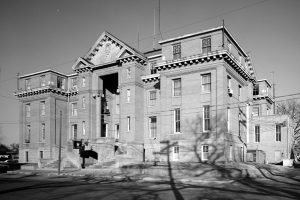 were soon tried and convicted. “Like all deputies of her era, she had to be extremely tough and ready to face a wide range of situations,” the U.S. Marshals Service wrote of Carnutt.
were soon tried and convicted. “Like all deputies of her era, she had to be extremely tough and ready to face a wide range of situations,” the U.S. Marshals Service wrote of Carnutt.
While it was unusual, there were a number of women in law enforcement, even before it was widely accepted as normal. All these women forged the way for the many women we have in law enforcement, and even in the military today. these women may have been the “clean up” crew, but they were a tough as nail clean up crew, and they made, and continue to make, history in the field of law enforcement, and in the military.
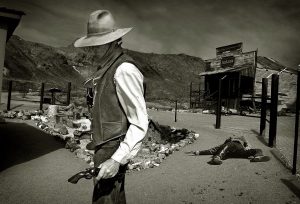 When we think of the outlaws of the old west, the term “gunfighter” or “gunslinger” were not the terms used to describe those men, or even the lawmen that some of them became upon changing their ways. They were actually originally called pistoleers, shootists, bad men, or one we do know…gunmen. That being said, Bat Masterson, who was a noted gunfighter himself, who later became a writer for the New York Morning Telegraph, sometimes referred to them as “gunfighters,” but, more often as “man killers.”
When we think of the outlaws of the old west, the term “gunfighter” or “gunslinger” were not the terms used to describe those men, or even the lawmen that some of them became upon changing their ways. They were actually originally called pistoleers, shootists, bad men, or one we do know…gunmen. That being said, Bat Masterson, who was a noted gunfighter himself, who later became a writer for the New York Morning Telegraph, sometimes referred to them as “gunfighters,” but, more often as “man killers.”
I suppose that Bat Masterson was probably the one who coined the term “gunfighter” in the first place, but many people from that era must have thought it an odd term to use. Still, if you heard an outlaw called a pistoleers, wouldn’t you have wondered what that was supposed to be? I would have, but then I would have looked it up and found that a pistoleers was “a soldier armed with a pistol.” That would have made no sense to me either, but in reality, some of the outlaws were soldiers who didn’t want to fight for a cause they didn’t believe in, so their deserted and headed west, so I guess they could have been pistoleers.
Another “movie mix-up” that happened is that in the old west, pistoleers or shootists didn’t squarely face off with each other from a distance in a dusty street, like they would like us to believe. In reality, the “real” gunfights of the Old West were rarely that “civilized.” Many fought in the many range wars and feuds of the Old West, which were far more common that the “stand-off” gunfight. Most of these were fought over land or water rights, some were political, and others were simply “old Hatfield-McCoy” style differences between families or in lifestyles. These people fought from the protection of anything available like a watering trough, a wall, building, or even a horse. Of those that more easily fit the perception of the “gunfighter,” you would find that they didn’t kill anywhere near the number of men they are credited with on television. In many instances their reputations stemmed from one particular fight, and the rumors grew from there, making people think they were that good. In other cases, self-promotion led people to believe they were lethal shootists, such was the case with Wyatt Earp and Wild Bill Hickok.
There were other, lesser known shootists, who actually saw just as much, if not more action than their well-known counterparts. Men like Ben Thompson, Tom Horn, Kid Curry, Timothy Courtright, King Fisher, Scott 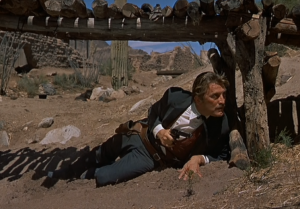 Cooley, Clay Allison, and Dallas Stoudenmire, just to name a few, were often not credited for nearly the shooting ability of the well known shooters. Often these gunfighters, whose occupations ranged from lawmen, to cowboys, ranchers, gamblers, farmers, teamsters, bounty hunters, and outlaws, were violent men who could move quickly from fighting one side of the law to the other, depending on what suited them best at the time. Though many of these gunman died of “natural causes,” many died violently in gunfights, lynchings, or legal executions. The average age of death was about 35. However, of those gunman who used their skills on the side of the law, they would persistently live longer lives than those that lived a life of crime.
Cooley, Clay Allison, and Dallas Stoudenmire, just to name a few, were often not credited for nearly the shooting ability of the well known shooters. Often these gunfighters, whose occupations ranged from lawmen, to cowboys, ranchers, gamblers, farmers, teamsters, bounty hunters, and outlaws, were violent men who could move quickly from fighting one side of the law to the other, depending on what suited them best at the time. Though many of these gunman died of “natural causes,” many died violently in gunfights, lynchings, or legal executions. The average age of death was about 35. However, of those gunman who used their skills on the side of the law, they would persistently live longer lives than those that lived a life of crime.
 When a crime is committed, it seems to take forever to bring justice for the victims. Sometimes people just don’t want to wait, or they are so mad about the crime committed against them or their family, that they decide, either consciously or unconsciously, to take matters into their own hands. This is known as vigilante justice, and while we still have it today, it really was more prevalent in the Old West….at least as it applies to storming the jail and hanging the “criminal” accused of the crime, without a trial.
When a crime is committed, it seems to take forever to bring justice for the victims. Sometimes people just don’t want to wait, or they are so mad about the crime committed against them or their family, that they decide, either consciously or unconsciously, to take matters into their own hands. This is known as vigilante justice, and while we still have it today, it really was more prevalent in the Old West….at least as it applies to storming the jail and hanging the “criminal” accused of the crime, without a trial.
Vigilante justice was more common in the wild west days because law enforcement was almost non-existent. Vigilantes took it upon themselves to “enforce the law,” as well as their own moral code, even if the event was not necessarily against the law. When a mob would decide that a prisoner is guilty, they would storm the jailhouse, drag the prisoner out, down the street to a big tree, and there they would hang the prisoner, whether they were guilty or not. The mob had decided. I suppose that a lot of times the person who was hanged was guilty of the crime, but without a trial and evidence to prove their guilt, how could anyone be sure?
The term vigilante stems from the its Spanish equivalent, meaning private security agents, but the vigilantes of 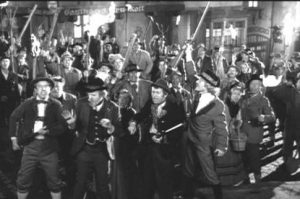 the old west and the mobs, who riot for their idea of right these days, have little in common with security agents. Most vigilantes and mobs are driven anger and adrenaline. Unfortunately those two things together don’t often bring a good outcome, and in the case of lynch mobs, it’s never a good outcome. Old West vigilantes were most common in mining communities, but were also known to exist in cow towns and in farming settlements. These groups usually formed before law and order existed in a new settlement. The justice dished out included whipping and banishment from the town, but more often, offenders were lynched. And sometimes the vigilante groups formed in places where lawmen did exist, but were thought to be weak, intimidated, or corrupt.
the old west and the mobs, who riot for their idea of right these days, have little in common with security agents. Most vigilantes and mobs are driven anger and adrenaline. Unfortunately those two things together don’t often bring a good outcome, and in the case of lynch mobs, it’s never a good outcome. Old West vigilantes were most common in mining communities, but were also known to exist in cow towns and in farming settlements. These groups usually formed before law and order existed in a new settlement. The justice dished out included whipping and banishment from the town, but more often, offenders were lynched. And sometimes the vigilante groups formed in places where lawmen did exist, but were thought to be weak, intimidated, or corrupt.
Some people see vigilantes as heroes, thereby giving them he support of some of the law-abiding citizens. Some people saw them as a necessary step to fill a much needed gap. Nevertheless, sometimes the vigilance committee began to wield too much power and became corrupt themselves. At other times, vigilantes were nothing more than ruthless mobs, attempting to take control away from authorities or masking themselves as “do-gooders” when their intents were little more than ruthless or they had criminal intent on their own minds. One of the first vigilante groups formed was the San Francisco Vigilantes of 1851. After several criminals were hanged the committee was disbanded. When the city administration, itself, became corrupt, a vigilante group formed once again in 1856. There were many vigilante groups formed in the American West. The Montana 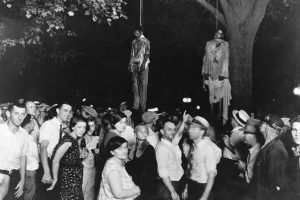 Vigilantes who hanged Bannack Sheriff Henry Plummer in 1864. They controlled the press, so the sheriff was made out to be the leader of an outlaw gang called the Innocents. Further investigation indicates that it might have been the vigilante group, themselves, who were behind the chaos reigning in Montana and that Henry Plummer was an innocent man. Following the Civil War, the Reno Gang began to terrorize the Midwest, resulting in the formation of the Southern Indiana Vigilance Committee. The next time the Reno Gang attempted to rob a train, a the vigilante group lynched its leaders…Frank, William and Simeon Reno. Vigilantes did good in some instances, but it was not really the best form of justice.
Vigilantes who hanged Bannack Sheriff Henry Plummer in 1864. They controlled the press, so the sheriff was made out to be the leader of an outlaw gang called the Innocents. Further investigation indicates that it might have been the vigilante group, themselves, who were behind the chaos reigning in Montana and that Henry Plummer was an innocent man. Following the Civil War, the Reno Gang began to terrorize the Midwest, resulting in the formation of the Southern Indiana Vigilance Committee. The next time the Reno Gang attempted to rob a train, a the vigilante group lynched its leaders…Frank, William and Simeon Reno. Vigilantes did good in some instances, but it was not really the best form of justice.
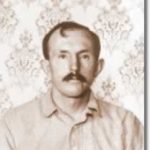 The old West as a wild place with very little law enforcement, and there was a lot of distance between lawmen. That also left room for may forms of lawlessness. I can’t say for sure that the gun for hire started in the old West, but it seems plausible. One such “gun for hire” was Thomas “Tom” Horn Jr, who often used the alias of James Hicks. Horn was born in Memphis, Missouri on November 21, 1860. He would become one of the most celebrated hired guns of the Old West, winning national fame for his freelance work, due in large part to his autobiography. Nevertheless, he wound up on the gallows for practicing his trade.
The old West as a wild place with very little law enforcement, and there was a lot of distance between lawmen. That also left room for may forms of lawlessness. I can’t say for sure that the gun for hire started in the old West, but it seems plausible. One such “gun for hire” was Thomas “Tom” Horn Jr, who often used the alias of James Hicks. Horn was born in Memphis, Missouri on November 21, 1860. He would become one of the most celebrated hired guns of the Old West, winning national fame for his freelance work, due in large part to his autobiography. Nevertheless, he wound up on the gallows for practicing his trade.
Tom was the fifth of 12 children, and his father, Tom Horn Sr, was a strict disciplinarian. Apparently, Tom didn’t like his dad’s strict ways, so he ran away in 1874 at the age of 14. Horn headed west…first to Santa Fe, then on to Arizona. By the time he was 15, he was an army scout and involved in many campaigns for more than a decade, including Geronimo’s surrender in 1886, in which Horn said he played a major role. During that time he also learned Spanish. As to his own account, Horn writing that he played a big role in the surrender of Geronimo, many historians doubt that, and actual accounts of that day indicate that Tom was there solely as a Spanish to English interpreter. After the surrender of Geronimo, Horn was discharged as a scout and reportedly mined for a while in Aravaipa, Arizona. Other than his autobiography, little is known about this period of his life for sure. We know that he was involved somehow with the Pleasant Valley War between Arizona cattlemen and sheepmen, but for which side is not clear.
It was during this time he decided to give law enforcement a try. In 1890, after proving himself during a short stint as a deputy sheriff in Arizona, Horn joined the Pinkerton Agency as a roving gunman, and using his gun with lethal effectiveness, tracked down dozens of outlaws, reputedly killing 17 men. He was pressured to resign by the agency, even though he was respected as a tracker. It seemed that with Horn came bad publicity. Horn decided to go it alone as a cattle detective, turning up in Wyoming in 1894 working for the beef barons. Horn denied killing anyone for the Pinkertons. Nevertheless, he was offering the same lethal services to the cattlemen, who were engulfed in what is known as the Johnson County War. As a “Stock Detective”, for each cattle rustler he shot, he charged $500-$600 and proved himself to be a methodical manhunter and ruthless killer. Horn once said “Killing men is my specialty. I look at it as a business proposition, and I think I have a corner on the market.”
After a short stint in Tampa, Florida working as a packer during the Spanish American War in 1898, Horn contacted Malaria and once mended, he headed back to Wyoming and returned to his dealings as a “gun for hire”. Records show that he was hired to stop cattle rustling in Brown’s Hole, Colorado in 1900, at which time he was going by the name James Hicks. He would boast in a letter, “I stopped cow stealing in one summer”, 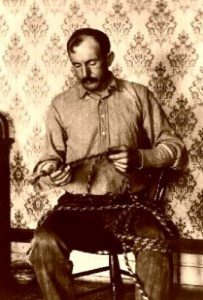 this being after he killed two area ranchers and scared the rest of the rustlers out of the area. In mid July, 1901, William Nickell, the 14 year old son of a sheep rancher, was ambushed and killed in the Iron Mountain region, allegedly due to a case of mistaken identity, as the bullet was meant for his father. About a week later, the boy’s father, Kels Nickell, was shot in the arm and hip during another ambush. U.S. Deputy Marshal Joe LeFors suspected Horn’s involvement. LeFors, wanting to gain a confession out of Horn, pretended to be in need of someone to take on a rustler clean up job in Montana. During this famous interview, Horn admitted to the Nickell’s shootings, not knowing that there was a court reporter hiding and taking notes. Ultimately, the interview would be his undoing. Although Horn alleged at his trial that he was drunk during the interview, he was found guilty on October 23, 1902, with the Wyoming State Supreme Court denying him a new trial. He was sentenced to hang, which was carried out in Cheyenne, Wyoming on November 20, 1903.
this being after he killed two area ranchers and scared the rest of the rustlers out of the area. In mid July, 1901, William Nickell, the 14 year old son of a sheep rancher, was ambushed and killed in the Iron Mountain region, allegedly due to a case of mistaken identity, as the bullet was meant for his father. About a week later, the boy’s father, Kels Nickell, was shot in the arm and hip during another ambush. U.S. Deputy Marshal Joe LeFors suspected Horn’s involvement. LeFors, wanting to gain a confession out of Horn, pretended to be in need of someone to take on a rustler clean up job in Montana. During this famous interview, Horn admitted to the Nickell’s shootings, not knowing that there was a court reporter hiding and taking notes. Ultimately, the interview would be his undoing. Although Horn alleged at his trial that he was drunk during the interview, he was found guilty on October 23, 1902, with the Wyoming State Supreme Court denying him a new trial. He was sentenced to hang, which was carried out in Cheyenne, Wyoming on November 20, 1903.
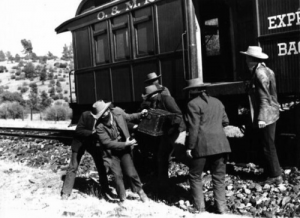 There are people these days who think we should get rid of the police officers, but they are obviously not thinking about the Old West. In the early days of the Old West, there were no law men. People had to take care of themselves. And contrary to what you might think, many people didn’t just carry a gun everywhere then either. That basically left them defenseless in many situations. On this day October 6, 1866, the Reno Gang carried out the first robbery of a moving train in United States history. Prior to that day, trains had been robbed while they were at the stations or in the freight yards, but that was proving to be a little dangerous, as the lawmen that were in the west were mostly in the towns. The Reno Gang changed the way criminals thought about things.
There are people these days who think we should get rid of the police officers, but they are obviously not thinking about the Old West. In the early days of the Old West, there were no law men. People had to take care of themselves. And contrary to what you might think, many people didn’t just carry a gun everywhere then either. That basically left them defenseless in many situations. On this day October 6, 1866, the Reno Gang carried out the first robbery of a moving train in United States history. Prior to that day, trains had been robbed while they were at the stations or in the freight yards, but that was proving to be a little dangerous, as the lawmen that were in the west were mostly in the towns. The Reno Gang changed the way criminals thought about things.
I’m not sure if their plan would have been considered innovative exactly, but as crime goes, I suppose it was. 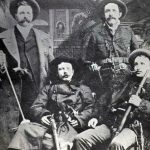 Their idea was that if they robbed the train in some remote area of the track, the crew of the train, and the people on it would be at their mercy, and they could take what they chose to. That first moving train robbery was on an Ohio and Mississippi train in Jackson County, Indiana, and netted the gang a profit of $10,000. It was a piece of cake, because there was no one to save the people on board. While I don’t believe anyone died, they were all very scared.
Their idea was that if they robbed the train in some remote area of the track, the crew of the train, and the people on it would be at their mercy, and they could take what they chose to. That first moving train robbery was on an Ohio and Mississippi train in Jackson County, Indiana, and netted the gang a profit of $10,000. It was a piece of cake, because there was no one to save the people on board. While I don’t believe anyone died, they were all very scared.
The news of this new type of robbery traveled fast, and before long, trains became a moving target. There were gangs, like Butch Cassidy’s Wild Bunch who found train robbery so easy and profitable, that for a time, it became their specialty. The large stashes of cash and precious minerals on the trains and the sparsely populated landscape, gave the gangs just what they needed for success. Nevertheless, like all crime, eventually 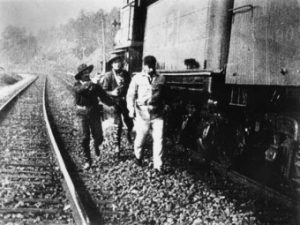 precautions were taken to prevent continued loss. By the late 1800s, robbing trains became increasingly dangerous. Railroad owners started protecting their trains’ valuables with large safes, armed guards, and fortified boxcars.
precautions were taken to prevent continued loss. By the late 1800s, robbing trains became increasingly dangerous. Railroad owners started protecting their trains’ valuables with large safes, armed guards, and fortified boxcars.
The Reno Gang was finally captured in 1868 after a series of robberies. That December saw another type of problem that develops when there is a lack of lawmen…vigilante justice. A mob of the citizens of the town, stormed the jail and hanged the brothers, Frank, Simeon, and William Reno and fellow gang member, Charlie Anderson. Their brother John Reno had been caught earlier and was serving time in a different prison.

